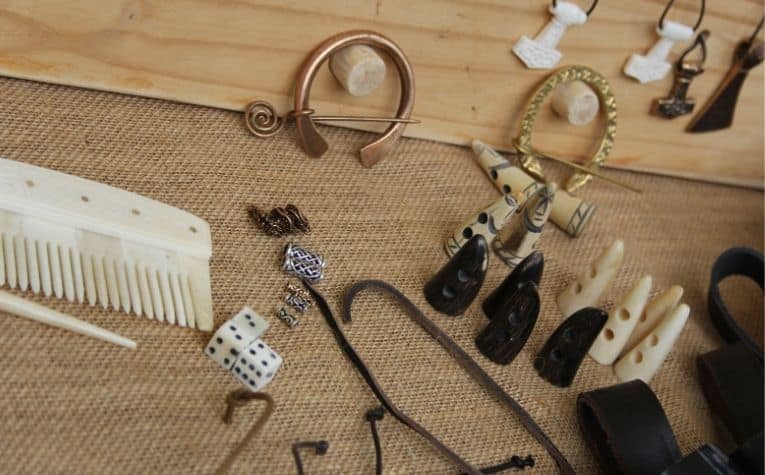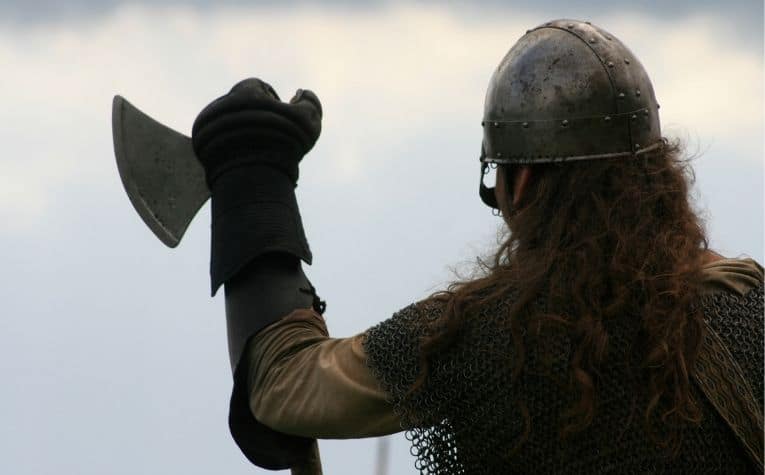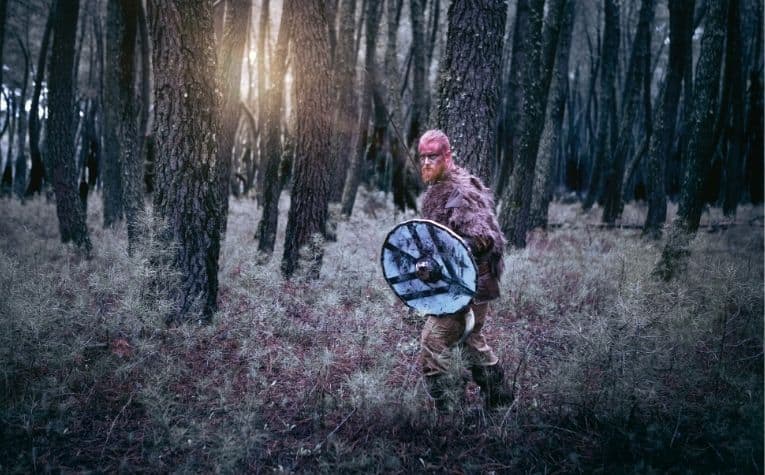As they tore through Northern Europe during the Middle Ages, descriptions of the marauding bands of warriors known as the Vikings emerged from victims and witnesses that were left in their wake.
These pointedly biased accounts portraying the Vikings as filthy and bloodthirsty savages spread as their conquests expanded.
What is now known, however, is that the Vikings’ hygiene was better than most.
Contrary to popular belief, the Vikings bathed regularly and washed their hair with soap containing lye, which contributed to their cleanliness and bleached it blonde while keeping it free from headlice.
While there is no evidence of brushes, Vikings kept their teeth clean with picks.
Plundering monasteries and sacking coastal villages while seeking better fortunes in new lands was dirty and often bloody work.
While age-old descriptions of Vikings will never completely fade away, historians and archaeologists have labored to portray these people of the north in a more accurate light.
They have found that the Vikings also wielded combs in addition to their iconic swords and axes.
A lot of people wonder what the Vikings looked like. See Did the Vikings Have Piercings? to learn more.

Here is How (Often) Vikings Washed their Hair
The Vikings did not document their own history, so that task was left either to parties who witnessed their activities firsthand or to outside observers who, more often than not, were somewhat biased in their portrayal of these Norse people. (Also see Why Did the Vikings Say Skol?)
Thankfully, archeologists and scholars have painstakingly pieced together more accurate depictions of their lives based on physical evidence and reliable historical accounts, and some of what they have been able to reveal may be startling to many, including the Vikings’ personal hygienic practices.
The Vikings Bathed Regularly
The Viking Age (793 – 1066 CE) took place during the Middle Ages, a period of time when the people of Europe lived in harsh and difficult conditions and when life expectancy rarely surpassed one’s thirties or forties, even for those who never set foot on a battlefield. (Also see Did the Vikings Have Red Hair?)
Simply put, living conditions were poor and hygienic practices were nowhere near what would be considered minimally adequate today.
Yet, the Vikings as a society encouraged its citizens to bathe themselves and do so regularly: weekly, as a matter of fact.
Bathing was such an integral part of life for the Vikings that they referred to the day known as Saturday as Laugardagur, which translates to “bathing day.”
Ironically, the people who most fervently considered the Vikings to be filthy and godless barbarians, namely Christians and Anglo-Saxons, bathed themselves but once per year by comparison. [1]
The Vikings had many interesting customs. See Did the Vikings Paint Their Faces? to learn more.
The Vikings Used Lye Soap to Keep Clean and Blonde

The Viking weekly bathing regimen, which included washing their hair, involved using a strong soap made from animal fat and wood ash.
This latter component was significant in several ways. When processed by the Vikings, the wood ash produced lye, which as an alkali made soap when mixed with the fat from animals.
The lye soap used by Vikings also had the effect of bleaching their hair blonde, which by many accounts was a highly desirable attribute, and not just for Norse women.
Scholars believe that Viking men, even their fiercest warriors, purposely left lye soap in their hair and beards to produce the signature blonde locks and facial hair that were all the rage during the Viking Age.
(Not all Scandinavians are natural blondes, many people from Denmark and Norway are natural brunettes and redheads.) [2] [3]
Vikings not only Washed their Hair, They Combed It
Items like swords, shields, and even ships, have for centuries been the gold standard of Viking artifacts, stirring up excitement with each discovery.
However, smaller, less newsworthy objects pull back the curtain on how the Vikings truly lived.
For instance, among the most common finds excavated from Viking sites are items that were used purely for grooming and personal care purposes, including:
- Razors
- Tweezers
- Ear spoons (for the removal of ear wax)
- Combs
Combs are among the most common items recovered from Viking excavations. Historians believe they were considered so essential that they were as likely to be hung from a warrior’s belt like a sword or knife.
These grooming items were apparently not only for combing the hair on their heads but also for preventing their long beards from becoming unkempt. [4]
Viking combs were typically made from reindeer antlers and featured exquisite craftsmanship.
In addition to having fine teeth, some were decorated with ornate carvings, demonstrating just how valuable these seemingly humble items truly were in the eyes of their owners.
This is further supported by the fact that Vikings were traditionally buried with items considered important in life and needed in the afterlife.
Their combs have been found among these artifacts. [5]
Even the names taken by prominent members of their society reflected how important Viking hairstyles were.
Prominent Norse royalty included familiar figures such as:
- Sweyn Forkbeard, who presumably styled his beard into two halves
- Harald Fairhair, whose moniker suggests a well-groomed head of hair [6]
Cleanliness was important in Viking culture, in part for health reasons. See How Did the Vikings Bathe? to learn more.
The Vikings’ Appearance Didn’t Go Unnoticed

Despite the terror they instilled in people throughout Northern Europe, the Vikings were also recognized for their personal hygiene, which was centuries before its time by Medieval European standards.
In fact, the English historian (and monk) John Wallingford noted the weekly bathing habits of the Viking warriors who besieged the British Isles and further lamented:
“It is in this way that they sieged the married women’s virtue and persuaded the daughters of even noblemen to become their mistresses.”
The Arabic scholar Ibn Fadlan also documented the Vikings’ cleaning habits, describing their daily ritual of washing their hands and faces and combing their hair from communal washbowls.
Although he was horrified by the fact that the people from the north passed soiled water from one man to the next (possible conjecture on his part), he confirmed that daily washings of some nature did take place. [7] [8]
This is How Vikings Kept Their Teeth Clean
Although scientists have found many grooming objects, Viking history’s archeological record is thus far devoid of toothbrushes or similar implements.
However, this does not mean that people from Sweden, Norway, and Denmark did not care about their dental needs.
Scientists have determined that the Vikings used picks to clean between and around their teeth from wear marks found on the teeth of skeletal remains.
Furthermore, the lack of sugar and scarcity of fruits and vegetables in their diet is the likely reason that virtually no cavities have been found in Viking teeth.
On the flip side, however, the Vikings likely suffered from abnormal wear of the enamel on their teeth due to the meats and unprocessed food they consumed daily.
Archaeological evidence suggests that they lost around ten percent of their teeth during their lifetimes.
Archaeological data also shows that many Vikings suffered from significant gum disease. [9]
The Vikings Filed Grooves in their Teeth
While the Vikings suffered from dental maladies that were a by-product of their diet and the times in which they lived, they also purposefully modified their teeth.
Archaeologists excavating at various sites have found Viking skulls with teeth bearing pronounced horizontal (and sometimes vertical) grooves filed into the enamel.
Interestingly, while the Vikings acquired many of their behaviors from the lands they conquered and traded with, no European cultures were known to have engaged in dental modifications such as these.
However, scholars have noted that certain native peoples in North America (the Great Lakes area) similarly altered their teeth.
Viking dental grooves have been observed in parallel groupings of two or three horizontal lines and were presumably made by skilled hands.
It is also theorized that these lines, when filled in with colored pigment, would have presented an intimidating sight to victims such as clergy or ordinary citizens. [10]
Final Thoughts
What is now known about the Vikings is that not all of them were warriors, and they had far better hygiene than is widely believed.
References:
[1] skjalden.com
[2] medievalists.net
[3] Mother Earth News
[4] danishnet.com
[5] york.ac.uk
[6] en.natmus.dk
[7] science nordic
[8] vkngjewelry.com
[9] nion.no
[10] history.com
